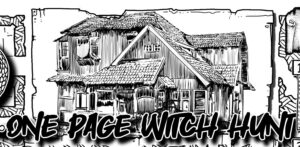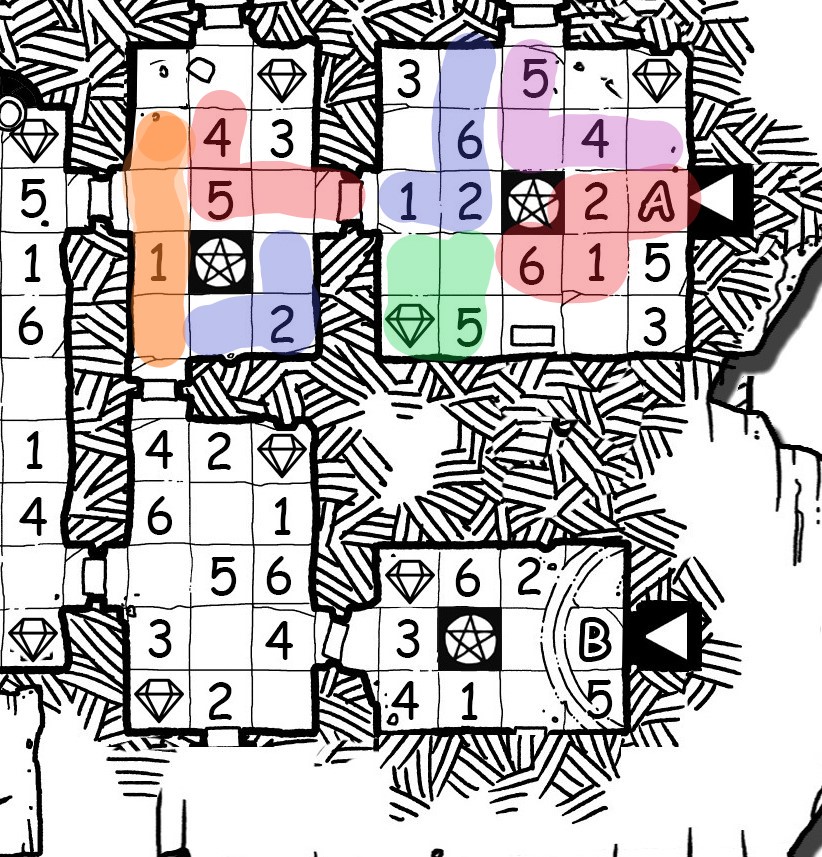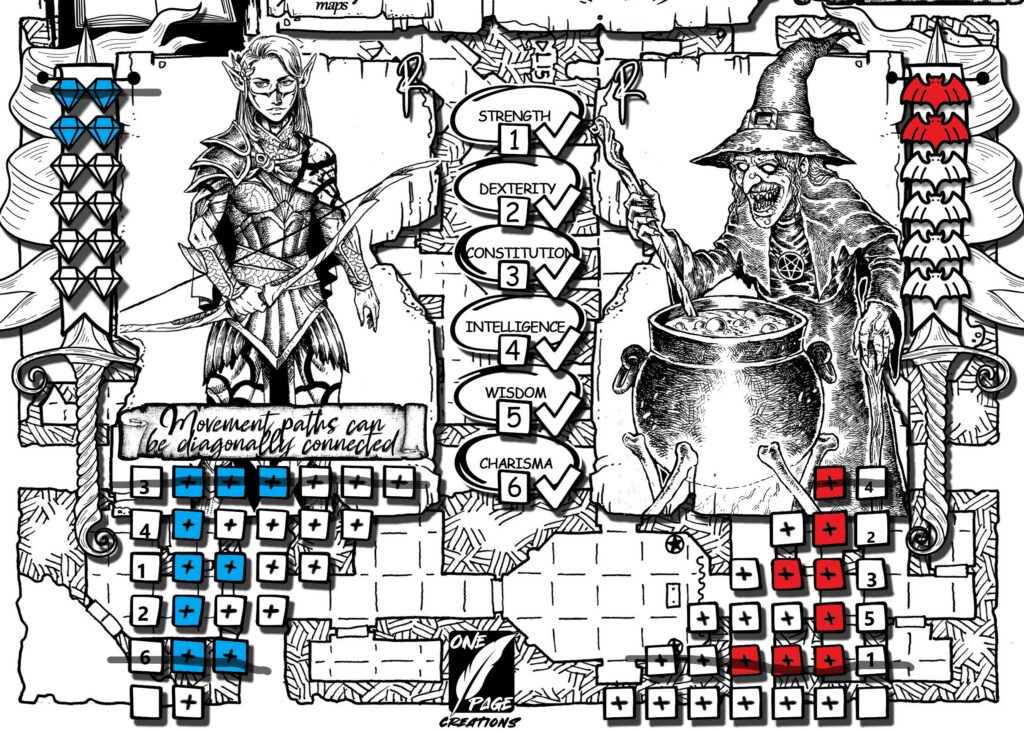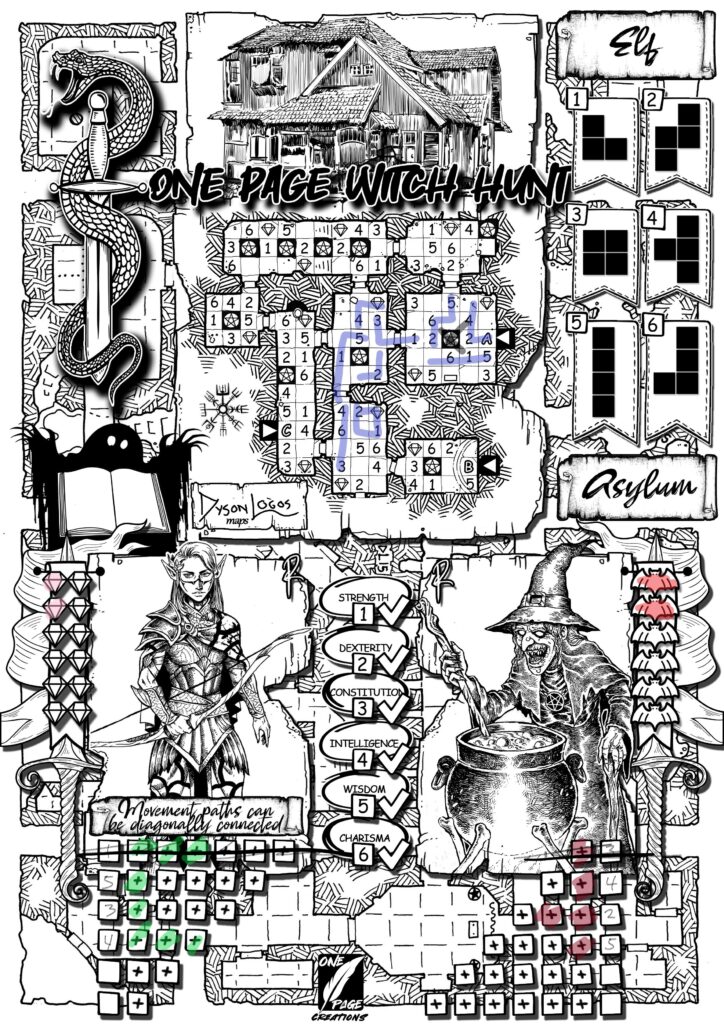Unplugged: One Page Monster Hunt (Boardgame)
 Roll and write games continue to permeate the boardgame market. We’ve come a long way from the days of Yahtzee, where a player would make repeated die rolls and then mark up their scorepad. Current trends still have players marking up their private sheets, but now die rolls are shared by all players, keeping everyone involved in each roll. In a somewhat recent trend, designers have reasoned that if a single sheet of paper has now taken the place of a game board, can’t we also get rid of the game box? The result is a minor explosion of designers publishing their own games in a print and play format. I am happy to stand behind this trend as this style of game is almost always beginner-friendly and, better yet, the game doesn’t take up space on my gaming shelves! One of the recent projects I’ve stumbled across is One Page Monster Hunt, currently finishing up a Kickstarter run, ending May 27th. It has players filling up a dungeon using Tetris-like shapes while trying to manage the attacks of the dungeon’s villainous monster.
Roll and write games continue to permeate the boardgame market. We’ve come a long way from the days of Yahtzee, where a player would make repeated die rolls and then mark up their scorepad. Current trends still have players marking up their private sheets, but now die rolls are shared by all players, keeping everyone involved in each roll. In a somewhat recent trend, designers have reasoned that if a single sheet of paper has now taken the place of a game board, can’t we also get rid of the game box? The result is a minor explosion of designers publishing their own games in a print and play format. I am happy to stand behind this trend as this style of game is almost always beginner-friendly and, better yet, the game doesn’t take up space on my gaming shelves! One of the recent projects I’ve stumbled across is One Page Monster Hunt, currently finishing up a Kickstarter run, ending May 27th. It has players filling up a dungeon using Tetris-like shapes while trying to manage the attacks of the dungeon’s villainous monster.
One Page Monster Hunt
Publisher: OnePage Creations
Players: 1+
Ages: 8+
Time: 30-60 min
(preview copy provided by publisher)
How to Play:
To play, one picks a hero and a monster to fight (I’ve only seen the Witch in my preview version.) Each hero plays roughly the same, with the addition of a small minor power that can be helpful. Each turn, two dice are rolled. One die will be used to indicate which Tetris-style shape will be drawn in the dungeon, while the second one will be assigned to the monster (the Witch in this case.) Shapes drawn on the dungeon board must always be orthogonally adjacent to a previously assigned shape. These shapes will cover up numbers, which are used to make the hero more powerful, and must be drawn to surround special Altar squares which are used by the hero to attack the monster.

The die assigned to the witch is used to improve its power by crossing off a box on the appropriate row. There are five rows of boxes and each time an unused number is assigned, it is recorded on the next row down. Future assignments of that number will be used to check off another box in that row. If ever a box is needing to be checked, and there are no more empty boxes in that row, the hero takes one point of damage, indicated by filling in one of the bat-shaped icons. If the bats are ever filled up, the hero is eliminated and the player loses the game.
The hero is also assigning numbers and filling in boxes on their side of the page. Each time a Tetris shape is drawn on the dungeon map, the player may select any one of the numbers covered up by that piece. They do a similar thing to the monster – checking off a box on the associated row or, if that number has not yet been assigned, starting a new row. (Note, the number for a row on the player’s side might not be the same number for the same row on the monster side.)

The goal of the game is for the hero to eliminate the monster by defeating them on each of the six rows. This is accomplished in two steps. First, the player must have completely surrounded one of the Altar squares on the dungeon board. They may then use that Altar to attack the monster on any undefeated row. If the number of crossed-out boxes on the player’s side of the row is greater than the number of crossed out boxes on the monster’s side, that row can be defeated. To defeat another row, a new Altar must be surrounded. Scattered around the dungeon map are gemstones. When a gemstone is covered up by a Tetris piece it is recorded on the hero side of the game sheet. Players can “spend” these gems in order to increase their side of the row when trying to defeat the monster.
The game is a race for the hero to cross out all of the monster’s rows (don’t forget you need a new Altar for each row) before the player takes too much damage from the monster. The monster damages the player whenever it can’t cross out a box or if the player is unable to fit the appropriate Tetris shape onto the map.
The heart of the game, as in most roll and writes, is assigning the dice. In this game, there are specific rules that must be followed. First, if only one of the two shapes rolled will allow a valid placement, the hero is assigned that number and the monster is left with the second number. If both dice would work (or neither work – which would damage the hero) the monster die is assigned as follows.
- The die assigned must be used to fill in an open box in an undefeated row.
- Otherwise, the die assigned must be used to fill in an open box in a defeated row.
- If there are no open boxes left, the die is assigned to an undefeated, filled row. Nothing is drawn, but the hero takes a point of damage – one of the bats is filled in.
- If the only matching rows are one that are defeated, either die can be assigned to the monster and the hero takes no damage.
Looking at the game sheet, one can see the differences in the rows. The monster starts with short rows while the hero has long rows. That means, in the long run, it will be easy for the hero to defeat this row. However, this also means the monster will be quicker to start damaging the hero when a die is assigned to that row. Later rows provide the monster with many more boxes – so it is less likely to damage the hero, but since the hero now has fewer boxes it makes it far more difficult to defeat that particular row. The end-game will often come down to a race to get enough gemstones to even things out to defeat those final few rows.
In a solo game, it is good enough for the hero to simply defeat the monster before they are eliminated. There are several different ways to play the game in a multiplayer setting.. The simplest is a race. Each player uses the same two dice, assigning them to their own board according to their choice- provided they follow all the rules. The first player to defeat the monster wins the game. The game can also be played cooperatively. In this mode, when one player defeats a row, all players may cross that one out. However, if one player takes damage, all players take damage. The final multiplayer mode has each player rolling their own two dice and then passing one of them to their neighbor before assigning their dice.
Verdict:
As far as roll and writes go, I found this one quite enjoyable. This style of game can easily become a rather dry, themeless exercise of optimization. The theme of One Page Monster Hunt manages to do a good job of avoiding this problem. Assigning Tetris pieces to the map generates a feel of dungeon exploration while the competing interests of the monster’s rows and a hero’s rows provides a bit of tension. Can I let that monster row accumulate boxes? It will let me avoid damage but will I be able to gather enough gems to finally defeat it when the time comes?
The best roll and write games allow a player some way to look beyond the current turn. On the map-drawing side of things, one must be sure to leave options open – if you cannot place a piece, not only is that a wasted turn, but the hero also takes damage. Altars must be surrounded on all four sides, which adds another complexity to the mix.
While this is not a game with multiple ways to win – you are pretty much just defeating the monster row by row – the game does have ways to change things up. Each type of hero provides a small, bonus power like drawing diagonally-adjacent shapes, winning ties when fighting the monster, or even limited access to a third die. The map also has three starting positions, corresponding to an easy, medium, or hard game simply by the way the doors, alters, and gemstones are spread around the map.
I am a big fan of cooperative games, so I have a special interest in the cooperative modes. This is still a preview so I haven’t tried things extensively but I greatly prefer the cooperative mode when dice are traded. It has the real danger of slowing the game down while everyone is trying to optimize what to pass. However, it also means everyone is engaged and it feels like we’re all in it together – something that is often lacking in roll and write games.

It’s not all a bed of roses – my one, tiny nitpick lies in the (still in development) game sheets themselves. Currently, they are far too “busy” for my tastes. I like the art style, there’s just so much of it I feel like it detracts from the game elements. Thankfully, they do not get in the way and once I’m into the game I do not notice them. It is more of a concern when I’m presenting the game to inexperienced gamers – the busy layout may scare them off a bit. However, that is only a small quibble and I like what I see of the rest of the game. I’m looking forward to see what is coming down the pipe. There are three new “monsters” that have already been unlocked in the course of the Kickstarter campaign – which, again, can be found here through May 27th.
Kid Factor
There’s no text to read or worry about. There’s the obvious connection to monsters (the Witch in this case) in line art





Discussion Area - Leave a Comment